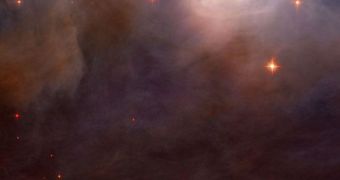Using its impressive Advanced Camera for Surveys (ACS), the Hubble Space Telescope has recently managed to snap a series of impressive photos of the Iris Nebula, a structure also known as NGC 7023. The nebula actually hides a stellar nursery, a region of intense stellar formation that produces new, blue stars at an impressive rate. The photographs show that impressive clouds of cosmic dust, which make up the prime-matter for the young celestial bodies in exquisite detail, Space reports.
For those of you who have an interest in observing the nebula for yourselves, you can find it in the direction of the constellation Cepheus, some 1,400 light-years away from our planet. The close-up shots focus exclusively on the northern regions of the nebula, and their depth-of-detail and resolution are owed to the numerous filters that were used in order to piece the image together. According to astronomers, the dust particles inside these massive, billowing clouds is 10 to 100 times smaller than the average dust grains you may find on your home furniture at home.
One reason why this nebula was selected for the Hubble observations was the fact that it appeared red in previous studies. Typically, reflection nebulae such as Iris appear blue. This happens because dust particles tend to filter and reflect blue light easier than they do red light. The nebula was also observed to be reflecting light coming in from a near-by massive star. The celestial body, known as HD 200775, has no less than ten times the mass of our own Sun. In addition to the ACS, experts in charge of the study also used the telescope's Near Infrared Camera and Multi-Object Spectrometer.
The last two were used in an attempt to determine the chemical composition of the Iris Nebula, the team says. The researchers assumed that some sort of hydrocarbon-based compounds must be at work inside the dust clouds, and force them to emit the unusual light. The structure is not hot enough to emit light on its own. Results from the chemical analysis have yet to come in, but scientists believe that they could provide them with further insight into how stars are formed inside stellar nurseries.

 14 DAY TRIAL //
14 DAY TRIAL //